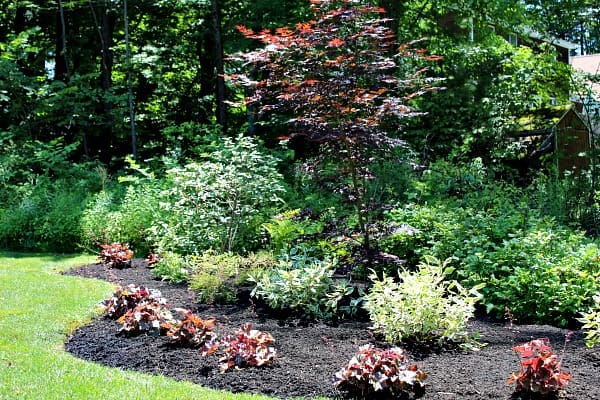Gardeners sometimes struggle when it comes to designing shade gardens. Use these tips to create a beautiful shade garden that stands out.
Shade gardens have a reputation of being a little harder to design for novice gardeners and do it yourselfers. People think their are fewer plant options, and a lot less color to work with. The truth is, some of the most impressive landscape designs are in the shade. Here are 6 tips to help you out when creating a shade garden.
1.) Astilbe Is the King
I remember reading an article awhile back that was titled “Astilbe is the king of the shade garden.” I have to agree.
A big problem in the shade garden is the lack of selection when it comes to flowering plants. Astilbe helps solve this problem. There are tons of different varieties and colors to choose from. I personally think Astilbe has one of the nicest flowers in any landscape, not just the shade garden.
Since Astilbe stays pretty small it is best planted toward the front and borders of your shade garden. They work well alongside Ferns and Hostas.
2.) Use Red Foliage
So many people get caught up in using flowering plants to add color to their landscape. Yes, flowers are great, but you can’t overlook the importance of different color foliage. Some of the best landscape designs have very little flowers and instead, very cleverly use different color foliage.
Red foliage plants , especially in the shade garden can create a lot of interest. Don’t overdo it though. The trick here is to have splashes of color and not have it overwhelm the whole garden.
Some popular red foliage plants for the shade garden are Japanese Maples, Ninebark, and ‘Palace Purple’ Coral Bells.
3.) Use Variegated Foliage
In addition to using red foliage plants, use variegated (cream color) foliage as well. In fact, planting red foliage with variegated foliage is a great combination and will make a beautiful contrast that stands out.
A popular favorite variegated shrub is the Ivory Halo Dogwood. They have a beautiful contrast next to, and around, Bloodgood Japanese Maples.
The Dappled Willow is also a great variegated foliage shrub. They do better when there is part sun, so if your shade garden gets a couple hours of sun then this plant is a great choice. They also do well in wet areas and are a great choice for areas of your landscape that are boggy.
4.) Have Fun With Hostas
Hostas are probably the first plant that comes to mind when thinking about a shade garden. It’s no surprise since there’s a lot of reasons to love Hosta. There are so many different varieties and they come in all kinds of colors, shapes, textures, and sizes. They also come back very reliably every year even after harsh winters.
Don’t be afraid to experiment with some unique varieties. Don’t be afraid to shop online since a lot of local nurseries and big box stores may have some more generic varieties.
I’ve become a big fan of bluish leaf hosta varieties including ‘Blue Angel’ Hosta and ‘Fragrant Blue’ Hosta. I also love hostas with obnoxiously big leaves like the ones found on the ‘Empress Wu’ variety.
5.) Consider Texture
It’s amazing how texture can create such different looks, and moods. Experiment with using a different textured plant within a group of plantings to make a focal point.
For example, you could have a Hosta variety with a big round leaf shape among a large grouping of Ferns and Astilbe which have a more fine texture.
If you want to create a landscape that’s easier on the eye then don’t make such sudden changes in texture. Varying textures and colors can make a design look busy and hard to look at, so don’t overdue it!
Repetition is a good thing in landscape design so don’t feel the need to plant a bunch of plants with opposing characteristics all next to each other.
6.) Big Shrubs Are Good Too
When it comes to the shade garden, don’t just think about perennials. Creating different heights in your garden bed is important. Large shrubs make a great backdrop for your shade garden, so don’t be afraid to use them. Hydrangeas, and Viburnums are great choices if looking to add size.
Check Out These Posts Next
Daylilies: Care, Maintenance, and Uses
Protecting Evergreen Shrubs From Winter
Follow Me
Join my free email list!



Hello Mark, I have a Red Dragon Japanese Red Maple that has lost its color, has become very pale. It is located in a partial shade, partial sun location surrounded by hostas. The leaves do not have any spots on them, just pale. Is this a characteristic of the plant? Does it need plant food? Thanks, Charles